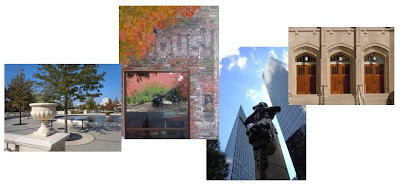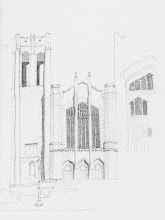I have visited the Wing Haven Gardens and Bird Sanctuary twice so far this past winter, and have been delighted both times. The gardens are enclosed within a red brick wall and within these walls one really feels like they have escaped somewhere. The sounds of nature, of birds chirping, the movement of chipmunks and squirrels, and the sounds of trickling water all take over here. All the better on a cool and sunny day in the winter, when the coming and going of sunshine provides moments of warmth.
 |
| rendered plan by Allison Merriman |
The site is planned as a series of formal gardens with axial relationships to one another. Yet, when one walks within, these axes are not always apparent. This is due largely to the nature of the height of the plantings which help obscure the brick walkways ahead. Many of the plantings are untrimmed, contrasting with the clipped hedges in the herb garden pictured above. Also, the walkways are narrow, most being wide enough for just one person, and there are many turns and curves, adding an element of surprise. All this results in a series of ‘discoveries,’ as one journeys through the gardens. There do exist a series of picturesque vistas from which you can see the spaces towards which you are walking, however, the element of surprise also exists here; this being more in tune with nature itself.
The home and gardens belonged to Elizabeth and Edwin Clarkson, who moved into the newly constructed house upon being married. At the time that the gardens were being made in 1927, materials that were readily available were used, both native and those found beyond the southeast. Now, the Wing Haven Foundation, which has owned the property since 1970, has put more of a focus on the use of native plants. There remain quite a variety of trees, plants, flowers, and herbs here that form these lovely gardens, which include woodlands on their north end.
There are also many other delightful elements throughout the garden such as statuary, a sundial in the herb garden, a pergola, and benches. The ones pictures below, past the iron gate, were referred to by the Clarkson’s as their “laughing benches” as they would sit here to enjoy watching birds flying and chipmunks running about.
Elizabeth Clarkson had an eye for good design that extended beyond gardening. While they were engaged, Elizabeth sent her ideas for the design of the house to Edwin, which he incorporated. These included large windows that would look out into their gardens, and a raised brick terrace off the living room for bringing her piano outdoors and entertaining. She also eventually designed the iron gates in the herb garden, incorporating the Clarkson “C” into their design.
During a time when Elizabeth had fallen ill and was bedridden, she turned her attention to the birds that she sighted in her gardens. She began to spend time outside on her cot, observing their behavior and educating herself on the various species. Her gardening interests expanded during this time to incorporate features that would attract more birds. This included various berries for birds to feed on, and trees whose buds attracted a variety of species. To this day, the gardens are replete with features that attract birds and provide for their food, nesting, and water.
Elizabeth often looked for ways to bring the outdoors inside her home and this eventually came to include the birds in the garden as well. Opposite her bed, she placed mirrors from which she could view both the gardens and the birds that were attracted to the feeder she placed outside her bedroom window. There had even been a time when the Clarksons were known to have bluebirds living openly within their very home.
Throughout the gardens one finds various quotations, poems, and prayers carved into plaques on the ground. These quotes had been collected over time by Elizabeth, from her varied readings, and eventually found their way into her gardens. One such quote is found upon exiting the gardens:
Life, believe, is not a dream
So dark as sages say;
Oft a little morning rain
Foretells a pleasant day.
-Charlotte Bronte
Indeed the above and several other quotes throughout the gardens show how the Clarksons saw their gardens as a place of escape and a source of inspiration. Having only seen the gardens in winter, I leave with the anticipation of seeing them in full bloom and further appreciating the design left to us by Elizabeth and Edwin Clarkson, tucked into a picturesque neighborhood in Charlotte.
Sources
Kratt, Mary Norton. A Bird in the House: The Story of Wing Haven Garden. Charlotte: Wing Haven Foundation, 1991.
“Visitor’s Guide to Wing Haven Gardens and Bird Sanctuary.” Wing Haven Gardens. Web.7 March 2012.
<http://www.winghavengardens.com/PDF/WHVisitors-Guide2011.pdf>


















